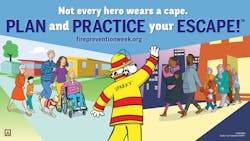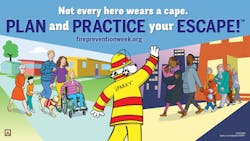NFPA Announces Theme for Fire Prevention Week 2019
The National Fire Protection Association (NFPA) has announced “Not Every Hero Wears a Cape. Plan and Practice Your Escape™!” as the theme for Fire Prevention Week, October 6–12, 2019. This year’s campaign recognizes the everyday people who motivate their households to develop and practice a home fire escape plan; these seemingly basic behaviors can have life-saving impact.
“This year’s campaign works to celebrate people of all ages who learn about home fire escape planning and practice, bring that information home, and spur their families to action,” said Lorraine Carli, vice president of Outreach and Advocacy at NFPA. “From young students who learn about the campaign at school to parents who attend a community event like a fire station open house—all of them truly are heroes because they’re taking steps to make their households much, much safer from fire.”“Not Every Hero Wears a Cape. Plan and Practice Your Escape!” also focuses on what a home escape plan entails and the value of practicing it. These messages are more important than ever, particularly because today’s homes burn faster than ever. Carli notes that synthetic fibers used in modern home furnishings, along with the fact that newer homes tend to be built with more open spaces and unprotected lightweight construction, are contributing factors to the increased burn rate.
“People tend to underestimate their risk to fire, particularly at home,” said Carli. “That over-confidence lends itself to a complacency toward home escape planning and practice. But in a fire situation, we’ve seen time and again that advance planning can make a potentially life-saving difference.”
A home escape plan includes working smoke alarms on every level of the home, in every bedroom, and near all sleeping areas. It also includes two ways out of every room, usually a door and a window, with a clear path to an outside meeting place (like a tree, light pole or mailbox) that’s a safe distance from the home. Home escape plans should be practiced twice a year by all members of the household.
For more information about Fire Prevention Week and “Not Every Hero Wears a Cape. Plan and Practice Your Escape!,” along with a wealth of resources to help promote the campaign locally, visit fpw.org.
NFORS Exposure Tracker App Now Available
Firefighters on the front lines protecting their communities now have a valuable tool for recording and providing evidence of work-related exposures to help protect them against deadly cancers and other occupational hazards in the fire service.
The new National Fire Operations Reporting System (NFORS) Exposure Tracker is now available as an app for firefighters, paramedics or officers to create a personal diary for logging exposure and incident details in a private, encrypted and secure online environment.“This valuable tool will help provide firefighters with the documentation they need to show on-the-job exposure to a toxic soup of carcinogens and ensure they have the resources to get healthy and return to work,” says Harold A. Schaitberger, general president of the International Association of Fire Fighters (IAFF).
The NFORS Fire Fighter Exposure Tracker was developed through a partnership with the IAFF, the International Associations of Fire Chiefs (IAFC), Metropolitan Fire Chiefs Association, International Public Safety Data Institute (IPSDI) and other fire service experts and is funded by the U.S. Federal Emergency Management Agency’s (FEMA) Assistance to Firefighters Grant program and the Ramsey Social Justice Foundation.
“The information gathered in the NFORS Exposure Tracker will provide essential data to help researchers better understand toxic exposures on the fire scene and develop new treatments and prevention protocols for occupational diseases, including cancer—now the leading cause of death among firefighters,” says Dr. Lori Moore-Merrell, president and CEO of IPSDI.
As more governments enact legislation providing workers’ compensation coverage for firefighters who contract cancer or develop post-traumatic stress disorder (PTSD), the NFORS Exposure Tracker record provides detailed data on personal work-related exposures, which can be accessed anytime, even in retirement.
The IAFF and IPSDI are working together to assure that firefighters using the NFORS Exposure Tracker can also easily register to be part of the National Firefighter Cancer Registry and other major firefighter cancer studies by opting-in to share exposure data with researchers.
The Firefighter Cancer Registry, signed into law by President Donald Trump in 2018, will provide researchers with a centralized database to acquire an abundance of high-quality data, such as work history and number and type of incidents to determine how firefighters are contracting cancer.
Firefighters can download the NFORS Exposure Tracker App free from app stores and complete an individual profile. The profile and data entered is encrypted and secure. Fire departments will not have access to your data. Fire departments participating in the NFORS Analytics (CAD Module) will receive periodic aggregate reports about overall exposure trends—not individual reports.
Firefighters, paramedics and officers should encourage their fire departments to participate in this nationwide program to ensure that information about on-the-job exposures is readily available. By linking their fire department to NFORS Analytics, firefighters’ incident data will automatically load directly into their personal exposure record without additional data entry.
NFORS was created by fire service research partners, including the IAFC, the Metropolitan Fire Chiefs Association, IAFF, the International Public Safety Data Institute, Underwriters Laboratory (UL), the National Institute of Standards and Technology, the Urban Institute, the University of Texas at Austin and the Center for Public Safety Excellence.
Visit i-psdi.org for more information.
NFPA and mySidewalk Develop Community Risk Assessment Tool
The National Fire Protection Association (NFPA) and mySidewalk have announced a strategic collaboration that will combine industry-leading NFPA codes and standards, including NFPA 1300, Standard on Community Risk Assessment and Community Risk Reduction Plan Development, and related information, with mySidewalk’s innovative Community Intelligence Platform to create a user-friendly tool to assist communities with the risk assessment process. This digital tool will allow communities to quickly identify local risks to life and property, understand underlying conditions that may contribute to those risks, and activate teams to develop community risk reduction plans informed by data. mySidewalk’s technology is interactive, mobile friendly, and ADA compliant and will allow users to share their community risk assessments with stakeholders.
“Communities face myriad issues in the fire and life safety ecosystem and need a simple way to look at a number of data sources to identify their most pressing risks,” said Lorraine Carli, NFPA vice president of Outreach and Advocacy. “We are excited to combine relevant information and technology into a new resource that will ultimately help them better prioritize and assign resources against risks.”
For more information, visit nfpa.org.
Line-of-Duty Deaths
5 U.S. firefighters recently died in the line of duty. Two deaths were health related, one firefighter died from injuries suffered in fireground operations, one firefighter died from gunshot wounds at the scene of an incident and one firefighter died from an apparent suicide at the station. This edition of Firehouse is dedicated to these firefighters.
FIREFIGHTER KODY VANFOSSAN, 24, of the Christopher, IL, Fire Department, died on May 5. Vanfossan responded to a multi-alarm two-story vacant structure fire. Upon arrival, heavy smoke could be seen coming out of the top floor of the structure. Vanfossan, along with a second firefighter, began an interior attack on the fire. An additional firefighter later called for the two firefighters to exit the building. As the two firefighters started down steps in the rear of the building, the steps collapsed. While the second firefighter was able to make it out of the building, a Mayday was issued for Vanfossan. He was recovered from the building and placed into an ambulance where he was pronounced deceased. Investigation into the incident continues.
FIREFIGHTER MITCHELL F. LUNDGAARD, 36 of the Appleton, WI, Fire Department, died on May 15. Firefighters from the Appleton Fire Department, the Appleton Police Department, and the Gold Cross Ambulance Crew, responded to a medical emergency at the Valley Transit Center in downtown Appleton. While treating the patient, the situation escalated into shots being fired, striking Lundgaard, a police officer and a bystander. Aid was immediately rendered to Lundgaard and he was rushed to the ThedaCare Regional Medical Center, where he died from the injuries he sustained from the shooting. Investigation into the incident continues.
FIREFIGHTER WILLIAM N. FRANCK, 81, of the Willow Street, PA, Fire Company, died on May 12. Franck was performing scene safety at a motor vehicle accident. While at the accident, he suffered a stroke. He was immediately taken to Penn Medicine Lancaster General Hospital in Lancaster, PA, where he passed away a short time later.
LT. BARRY BOULTON, SR., 67, of the Plantation, FL, Fire Department, died on May 7. Boulton collapsed after completion of a rapid intervention team (RIT) drill. Resuscitation efforts were immediately rendered to Boulton who was then rushed to the Westside Regional Medical Center where he passed away from cardiac arrest.
SENIOR FIREFIGHTER/DRIVER ENGINEER Charles Ruffing, 53, of the Boise, ID, Fire Department, died on May 21. Ruffing, who had been diagnosed with post-traumatic stress disorder (PTSD), was found deceased in Boise Fire Department Station 6 as a result of a suicide.








